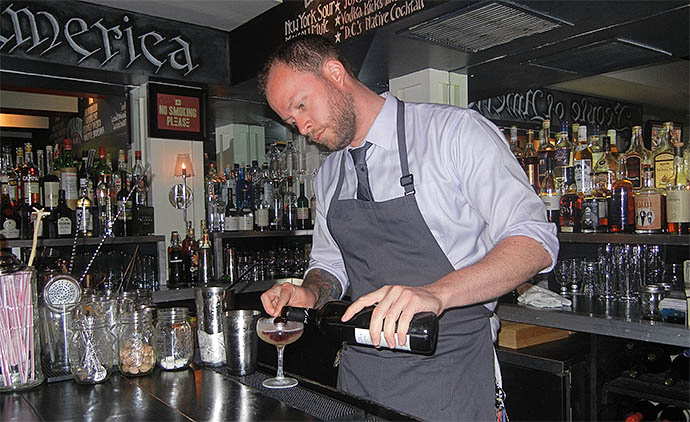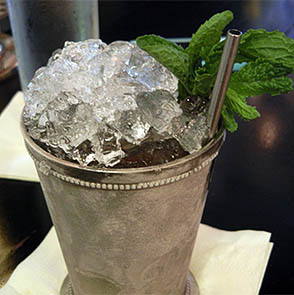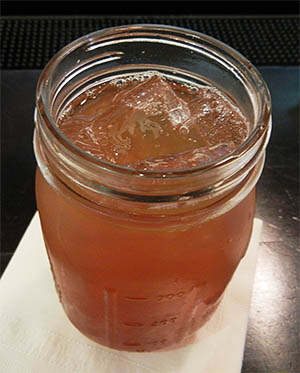Owen Thomson Mixes Cocktails with History at America Eats Tavern

To say that America Eats Tavern has the most educated bar staff in D.C. would be something of an understatement. Among them: a history buff, a radiologic tech, and Think Food Group’s beverage director himself — Owen Thomson, who holds both a B.A. in archaeology and a J.D. But these smarts aren’t being wasted over Jack and cokes; the Penn Quarter eatery that subsumed Café Atlántico in concert with the America Eats exhibit at the National Archives serves the most researched, highly historical libations in the district.
 After opening José Andrés’ latest ventures in Vegas last year, Thomson took over head ‘tending duties at America Eats, which focuses on early American recipes and ingredients as collected through research in partnership with the Foundation for the National Archives.
After opening José Andrés’ latest ventures in Vegas last year, Thomson took over head ‘tending duties at America Eats, which focuses on early American recipes and ingredients as collected through research in partnership with the Foundation for the National Archives.
“This is the equivalent of French cooking — the classical style,” says Thomson of the cocktail menu, inspired by unearthed recipes from the 1800s. In many cases, shaking up classic drinks means recreating old ingredients that today have been replaced with overly sweet syrups. For example: peach brandy, these days spiked with artificial sweeteners, is recreated the old-fashioned way, allowing the liquor to steep in a barrel with the fruit itself.
As Thomson describes it, the cocktail menu (which includes punches as well as choice tipples from the Colonial era and Golden Age) started off with hundreds of potential contenders — many culled from Jerry Thomas’ original 1862 bartender’s manual — and was whittled down to the list available today. What made the cut? Cocktails that pack as much history as they do flavorful punch.
The Milk Punch is made with none other than Benjamin Franklin’s personal recipe (it relies on a colonial technique of preserving milk with citrus); an artifact Thomson discovered in a letter from Franklin to his friend, now preserved by the Massachusetts Historical Society. “The most interesting cocktails to me are the ones with uncommon combinations,” says Thomson, including with that assessment the citrus-stoked, milk-like consistency of Franklin’s punch.
 By contrast, the Mint Julep, which also makes an appearance, is a cocktail that many recognize but few have enjoyed in purest form. Originally intended as hair-of-the-dog type breakfast drink, it’s almost pure booze — and best served ice cold in a proper julep cup. “It’s got a whole lot of whiskey,” admits Thomson.
By contrast, the Mint Julep, which also makes an appearance, is a cocktail that many recognize but few have enjoyed in purest form. Originally intended as hair-of-the-dog type breakfast drink, it’s almost pure booze — and best served ice cold in a proper julep cup. “It’s got a whole lot of whiskey,” admits Thomson.
The Switchel is another interesting choice, this one with roots as a field worker’s beverage due to its refreshing, citrusy taste. Before citrus was widely available (scurvy, anyone?) New Englanders used vinegar for the same acidic effect, combining it here with molasses and ginger for a quick pick-me-up on hot days.
The always-rotating beer list is equally well-conceived and highlights all-American beers not typically available in D.C.; Thomson’s been known to drive to Raleigh-Durham and beyond to pick up kegs of obscure brews. He also ensures there’s always a cider on tap: “It has a rich history in America,” he explains.
Is it any wonder that in a town like D.C., even the cocktail menus are researched, intellectual documents? It all just proves what we’ve long suspected: Washington takes drinking as seriously as it does politics.
From Thomson, the difference was obvious: “Either continuing to bartend or becoming a lawyer was an easy choice.”
Photos by Lauren Sloat






















